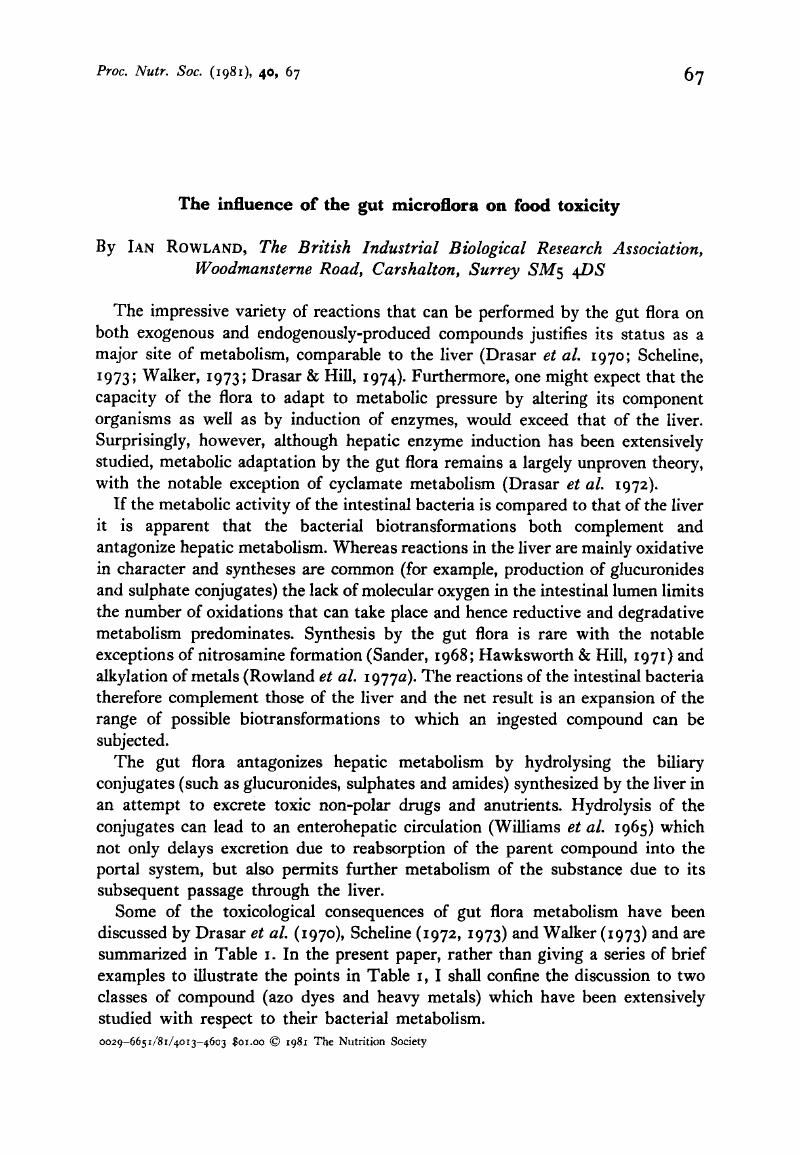Crossref Citations
This article has been cited by the following publications. This list is generated based on data provided by Crossref.
Wise, Alan
Mallett, Anthony K.
and
Rowland, Ian R.
1982.
Dietary protein and cecal microbial metabolism in the rat.
Nutrition and Cancer,
Vol. 4,
Issue. 4,
p.
267.
Mallett, A K
Rowland, I R
and
Wise, A
1983.
Interaction between pectin and rat hindgut microflora.
Applied and Environmental Microbiology,
Vol. 45,
Issue. 1,
p.
116.
Mallett, A K
Bearne, C A
and
Rowland, I R
1983.
Metabolic activity and enzyme induction in rat fecal microflora maintained in continuous culture.
Applied and Environmental Microbiology,
Vol. 46,
Issue. 3,
p.
591.
Mallett, Anthony K.
Wise, Alan
and
Rowland, Ian R.
1983.
Effect of dietary cellulose on the metabolic activity of the rat caecal microflora.
Archives of Toxicology,
Vol. 52,
Issue. 4,
p.
311.
VAHTER, MARIE
1983.
Biological and Environmental Effects of Arsenic.
p.
171.
Rowland, Ian R.
Mallett, Anthony K.
and
Wise, Alan
1985.
The Effect of Diet on the Mammalian Gut Flora and Its Metabolic Activities.
CRC Critical Reviews in Toxicology,
Vol. 16,
Issue. 1,
p.
31.
Kujawa, M.
Macholz, R.
Schulze, J.
and
Schnaak, W.
1987.
Die Bedeutung der Gastrointestinalflora für den Fremdstoffmetabolismus.
Food / Nahrung,
Vol. 31,
Issue. 5-6,
p.
619.
DRASAR, B.S.
1988.
Role of the Gut Flora in Toxicity and Cancer.
p.
23.
BROWN, JOSEPH P.
1988.
Role of the Gut Flora in Toxicity and Cancer.
p.
109.
MALLETT, A.K.
BEARNE, C.A.
and
ROWLAND, I.R.
1989.
The influence of incubation pH on the activity of rat and human gut flora enzymes.
Journal of Applied Bacteriology,
Vol. 66,
Issue. 5,
p.
433.
Zunft, H.‐J.
and
Schulze, J.
1991.
Lactose ‐ ein potentieller Ballaststoff. Zur Regulierung ihrer mikroökologischen Wirksamkeit im Intestialtrakt 4. Mitt. Ballaststoffwirkung der Lactose: Bewertung mit multivariaten statistischen Verfahren.
Food / Nahrung,
Vol. 35,
Issue. 9,
p.
921.
McConnell, M A
and
Tannock, G W
1991.
Lactobacilli and azoreductase activity in the murine cecum.
Applied and Environmental Microbiology,
Vol. 57,
Issue. 12,
p.
3664.
Chung, King-Thorn
Stevens, S. Edward
and
Cerniglia, Carl E.
1992.
The Reduction of Azo Dyes by the Intestinal Microflora.
Critical Reviews in Microbiology,
Vol. 18,
Issue. 3,
p.
175.
Chadwick, R. W.
George, S. E.
Kohan, M. J.
Allison, J. C.
Chang, J.
Long, J. E.
Duffy, M. C.
Dekker, J. P.
and
Forehand, L. R.
1993.
Effects of age, species difference, antibiotics and toxicants on intestinal enzyme activity and genotoxicity.
Environmental Toxicology and Chemistry,
Vol. 12,
Issue. 8,
p.
1339.
Kollarczik, Birgit
Gareis, Manfred
and
Hanelt, Monika
1994.
In vitro transformation of the Fusarium mycotoxins deoxynivalenol and zearalenone by the normal gut microflora of pigs.
Natural Toxins,
Vol. 2,
Issue. 3,
p.
105.
Nelson, G. M.
Allison, J.
Chadwick, R.
Creason, J.
and
George, S.
1996.
Development of anin vitroContinuous Flow Culture Model of the Murine Intestinal Tract.
Microbial Ecology in Health and Disease,
Vol. 9,
Issue. 3,
p.
97.
Tannock, Gerald W.
1997.
Gastrointestinal Microbiology.
p.
434.
Chung, King‐Thom
2000.
Mutagenicity and carcinogenicity of aromatic amines metabolically produced from Azo Dyes.
Journal of Environmental Science and Health, Part C,
Vol. 18,
Issue. 1,
p.
51.
Huang, Yang
Kotula, Lidija
and
Adams, Michelle C.
2003.
The in vivo assessment of safety and gastrointestinal survival of an orally administered novel probiotic, Propionibacterium jensenii 702, in a male Wistar rat model.
Food and Chemical Toxicology,
Vol. 41,
Issue. 12,
p.
1781.
Robosky, Lora C.
Wells, Dale F.
Egnash, Laura A.
Manning, Matthew L.
Reily, Michael D.
and
Robertson, Donald G.
2005.
Metabonomic Identification of Two Distinct Phenotypes in Sprague-Dawley (Crl:CD(SD)) Rats.
Toxicological Sciences,
Vol. 87,
Issue. 1,
p.
277.



